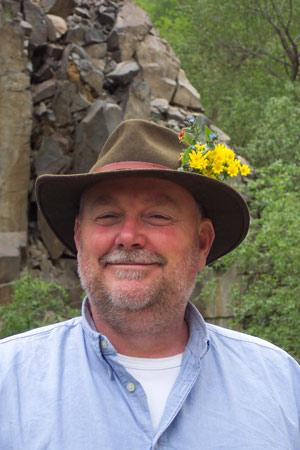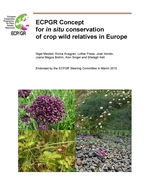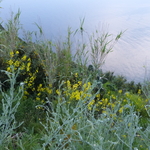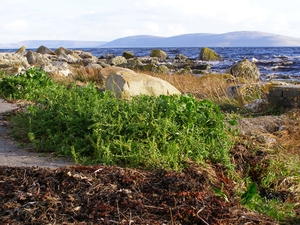Lathyrus palustris. Photo: Ivar Leidus

Chair
Nigel Maxted
nigel.maxted@dial.pipex.comConfirmed as Chair in February 2019
Vice-Chair
José María Iriondo Alegría
jose.iriondo@urjc.es
View CV (582,9 KB)
Grant Scheme Activities
Phase X
| First Call (2019) |
Phase IX
| Second Call (2015) | |
| First Call (2014) |
Working Group activities and related events
June 2024
A meeting of the 'Extension of EURISCO for Crop Wild Relatives (CWR) in situ data and preparation of pilot countries’ project took place in Sadovo, Bulgaria, on 18-19 June 2024. [More information]
December 2022
An ad hoc Crop Wild Relatives Working Group meeting took place on 13–15 December 2022 in Thessaloniki, Greece. [More information]
June 2022
The ECPGR Steering Committee accepted a request from the Working Group on Wild Species Conservation in Genetic Reserves to change their name to Crop Wild Relatives Working Group. The scope of the WG will cover in situ and ex situ strategies and techniques, as well as Wild Food Plants.
December 2021
The project 'Extension of EURISCO for Crop Wild Relatives (CWR) in situ data and preparation of pilot countries’ data sets' was approved by the German Federal Ministry of Food and Agriculture. Visit the project page
October 2021
Natural England and University of Birmingham have produced an introduction and identification guide to English CWR priority taxa, an example that could be followed by other countries in Europe (available here)
July 2021
The final activity report on Identification, preparation of applications and approval of sites to join the European in situ PGRFA conservation network (1 September 2019 – 1 March 2021), is published (available here)
October 2019
First meeting of the Activity “Inclusion of CWR sites in European in situ network": a Joint workshop with the Farmers' Pride Project took place 8-10 October 2019 in Santorini, Greece. [more info]
June 2019
The project on Identification, preparation of applications and approval of sites to join the European in situ PGRFA conservation network (Inclusion of CWR sites in European in situ network) submitted by the Wild Species Conservation in Genetic Reserves Working Group for funding under the First Call of the ECPGR Activity Grant Scheme for Phase X, was selected by the Executive Committee. [more info]
June 2019
Crop wild relative genetic reserves officially recognized in Europe for the first time
A genetic reserve network for four native wild celery species has been established in Germany. Five sites of celery wild relatives were officially designated on 4 June 2019. The network will be extended to 45 sites during the next months [read more] (271,5 KB)
May 2018
The Farmer’s Pride project has launched a stakeholder survey.
To help establish a new European network of conservation sites and stakeholders, the project partners are reaching out to identify individuals and organizations involved or with an interest in the conservation of wild and cultivated plant genetic resources (crop wild relatives and traditional local varieties, or landraces), whether in farms, gardens, allotment sites, protected and non-protected areas.
The survey is relevant to all stakeholders, including agro-NGOs, civil society organizations, farmers and gardeners, nature conservation NGOs, plant breeding/seed companies, policy-makers, protected area managers, research institutes, seed/gene banks, and any related networks or other relevant organizations.
July 2017
Farmer’s Pride project accepted
The proposal submitted by the Wild Species Conservation in Genetic Reserves Working Group and the On-farm Conservation and Management Working Group coordinating team (with key additional partners) for H2020 SFS 04 2017 was successful. The project formally starts on the 1st November 2017 and will run for 3 years.
Brief summary:
The overarching objective of Farmer’s Pride is to establish a network of stakeholders and conservation sites that effectively coordinates conservation actions to safeguard the wealth of Europe’s in situ plant genetic resources (PGR) and integrates the user community to maximize their sustainable use. Specifically, to address the challenge and scope of the SFS-04-2017 work programme, Farmer’s Pride will: a) build relationships between existing diverse PGR stakeholder networks, and where necessary create new partnerships to establish a unified network of stakeholders involved in PGR conservation and sustainable use; b) enhance existing knowledge of European landrace and crop wild relative genetic diversity and showcase how it can be effectively secured and managed; c) use social science and economic tools to establish the value of in situ PGR populations and individual traits, as well as a cost effective means of conserving them; d) use predictive characterization methods to identify valuable traits in in situ PGR populations, targeting those most vital for satisfying future agricultural and market needs; e) establish a mechanism to facilitate the flow of plant genetic material from in situ populations to the user community, both directly and via ex situ collections; f) develop and establish a durable governance and resourcing structure for the European network of in situ PGR conservation sites and stakeholders; g) promote public awareness of the value of PGR for agriculture and consumers; and h) design and implement a network of European sites and stakeholders that conserves the breadth of PGR diversity found in situ. Through these activities, Farmer’s Pride will result in significant strengthening of European capacities for the conservation, management and sustainable use of in situ PGR as a foundation for increased competitiveness in the farming and breeding sectors, and ultimately for long-term food and nutritional security in Europe.
June 2017
Innovative breeding research project underpins the value of genetic reserves
(A note by Lothar Frese and Gina Capistrano-Gossmann)
“Crop wild relative populations of Beta vulgaris allow direct mapping of agronomically important genes” is the title of a paper recently published in Nature Communications (Capistrano-Gossmann et al. 2017). The researchers used two CWR populations of Beta vulgaris subsp. maritima for fine mapping and rapid identification of a Rhizomania resistance gene. [read more] (38,5 KB)
April 2017
Crop wild relative conservation strategies: the final Activity Report and the proceedings of the Joint Nordic/ECPGR Workshop are now available online [here]
November 2016
A National training workshop “In situ conservation of crop wild relatives and diversity assessment techniques” took place 14-16 November 2016, Plant Breeding and Acclimatization Institute, Radzików, Poland. Programme (784,0 KB)
September 2016
The meeting of the Activity “CWR Conservation Strategies” was held 19–22 September 2016 in Vilnius, Lithuania, jointly with the Nordic project “Ecosystem services: Genetic resources and crop wild relatives in the Nordic countries”. [more info]
May 2016
The book “Enhancing Crop Genepool use: Capturing Wild Relative and Landrace Diversity for Crop Improvement” edited by N Maxted, University of Birmingham, UK, M Dulloo, FAO, Italy, B Ford-Lloyd, University of Birmingham, UK, has recently been published and is now available from the CABI website. A discount of 20% will be granted to all ECPGR WG members by using the discount code CCECG20.
February 2016
ECPGR WG for Forages towards 2020s (Forages 2020): the final Activity Report is now available online [here]
January 2016
“Genetic diversity of Patellifolia species (GeDiPa)”: the Interim Activity Report (covering the period February- December 2015) is now available online [here]
2015
December 2015
The project on: "Promoting implementation of national and regional crop wild relative (CWR) conservation strategies through sharing of knowledge and experience to create an integrated European strategy for CWR conservation", submitted by the ECPGR Wild Species Conservation in Genetic Reserves Working Group for funding under the second Call of the ECPGR Activity Grant Scheme, was selected by the Executive Committee. [more info]
November 2015
The Forages 2020 workshop took place 9-11 November 2015 in Alnarp, Sweden [more info]
March 2015
The ECPGR Concept for In situ Conservation of crop wild relatives in Europe (1,5 MB) has been endorsed by the ECPGR Steering Committee.
February 2015
The coordination meeting of the “Genetic diversity of Patellifolia species (GeDiPa)” project was held 17 February 2015 at Universidad Rey Juan Carlos, Madrid, Spain. [more info]
2014
December 2014
Two projects submitted for funding under the ECPGR Activity Grant Scheme and involving the Wild Species Conservation in Genetic Reserves Working Group were selected by the Executive Committee:
- “ECPGR WG for Forages towards 2020s (Forages 2020)” (Forages, Wild Species and D&I Working Groups)
- "Genetic diversity of Patellifolia species (GeDiPa)" (Beta and Wild Species Working Groups)
June 2014
Enhanced Genepool Utilization ‒ Capturing wild relative and landrace diversity for crop improvement. Joint international conference on utilization and conservation of crop wild relative (CWR) and landrace (LR) diversity for crop improvement of the PGR Secure consortium and the European Association for Research on Plant Breeding (EUCARPIA), 17–20 June 2014, NIAB Innovation Farm, Cambridge, UK.
2013
November 2013
''On the conservation and sustainable use of plant genetic resources in Europe: a stakeholder analysis". Workshop in Wageningen, November 25–29, 2013.
October 2013
'Crop Wild Relative' Issue 9 has been published [PDF] [more info and previous issue]
April 2013
Following the recommendations made by the Thirteenth meeting of the Steering Committee in Vienna (December 2012) a Task Force for “In situ conservation of crop wild relatives” has been established to develop agreed concepts at ECPGR level on in situ conservation of crop wild relatives.
Past events [link to ECPGR Archive]
Working Group operative documents
- Working Group Chair’s report for Phase IX (prepared for the Fifteenth ECPGR Steering Committee Meeting) (see here)
Background information
During the Eleventh Steering Committee meeting (Bosnia and Herzegovina, September 2008) it was recognized that the existing Task Forces of the In situ Conservation Network have long-term plans of action and therefore deserve the status of “Working Groups”. The two Task Forces were therefore converted into WGs.
Related Information
Other Working Group documents and publications
Useful links
Inventories/Checklists
- Crop Wild Relatives Global Portal
- Crop wild relative Newsletter
- Crop Trust - Conservation strategies
- Crop Wild Relative Data section of the U.S. National Plant Germplasm System
- European Red List
- European Red List of Vascular Plants (link to PDF)
- Euro+Med PlantBase - the information resource for Euro-Mediterranean plant diversity
- NordGen Crop Wild Relatives
- Italian Crop Wild Relative and Wild Harvested Plant checklist
- Italian databases for local varieties and crop wild relatives
- The Italian Flora of Human Interest
- Plant Search – Botanic Gardens Conservation International
- Spanish National Strategy for the Conservation and Use of Crop Wild Relatives and Wild Food Plants
- Crop Wild Relatives in the Netherlands
Tools
- Crop wild relatives in European protected areas
- DIVA: a geographic information system
- Web tool for CWR Population Management
Articles
- Ciancaleoni S, Raggi L, Barone G, Donnini D, Gigante D, Domina G & Negri V. The Italian flora of human interest
Project websites
- Cousin - Crop wild relatives utilisation and conservation for sustainable agriculture
- Farmer’s Pride - Conserving plant diversity for future generations
- AEGRO: An Integrated European In Situ Management Work Plan: Implementing Genetic Reserves and On Farm Concepts
- PGR Secure: Novel characterization of crop wild relative and landrace resources as a basis for improved crop breeding
- EU-funded PGRForum project: European Crop Wild Relative Diversity Assessment and Conservation Forum
Webinars


